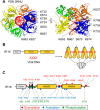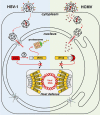The emerging role of nuclear viral DNA sensors
- PMID: 26354430
- PMCID: PMC4646299
- DOI: 10.1074/jbc.R115.652289
The emerging role of nuclear viral DNA sensors
Abstract
Detecting pathogenic DNA by intracellular receptors termed "sensors" is critical toward galvanizing host immune responses and eliminating microbial infections. Emerging evidence has challenged the dogma that sensing of viral DNA occurs exclusively in sub-cellular compartments normally devoid of cellular DNA. The interferon-inducible protein IFI16 was shown to bind nuclear viral DNA and initiate immune signaling, culminating in antiviral cytokine secretion. Here, we review the newly characterized nucleus-originating immune signaling pathways, their links to other crucial host defenses, and unique mechanisms by which viruses suppress their functions. We frame these findings in the context of human pathologies associated with nuclear replicating DNA viruses.
Keywords: IFI16; IFIX; STING; cGAS; cytokine induction; infectious disease; protein-DNA interaction; signaling; viral DNA sensing; viral immunology.
© 2015 by The American Society for Biochemistry and Molecular Biology, Inc.
Figures



References
-
- Arzumanyan A., Reis H. M., and Feitelson M. A. (2013) Pathogenic mechanisms in HBV- and HCV-associated hepatocellular carcinoma. Nat. Rev. Cancer 13, 123–135 - PubMed
-
- Weinstock H., Berman S., and Cates W. Jr. (2004) Sexually transmitted diseases among American youth: incidence and prevalence estimates, 2000. Perspect. Sex. Reprod. Health 36, 6–10 - PubMed
-
- Kojaoghlanian T., Flomenberg P., and Horwitz M. S. (2003) The impact of adenovirus infection on the immunocompromised host. Rev. Med. Virol. 13, 155–171 - PubMed
Publication types
MeSH terms
Substances
Associated data
- Actions
Grants and funding
LinkOut - more resources
Full Text Sources
Other Literature Sources
Research Materials

